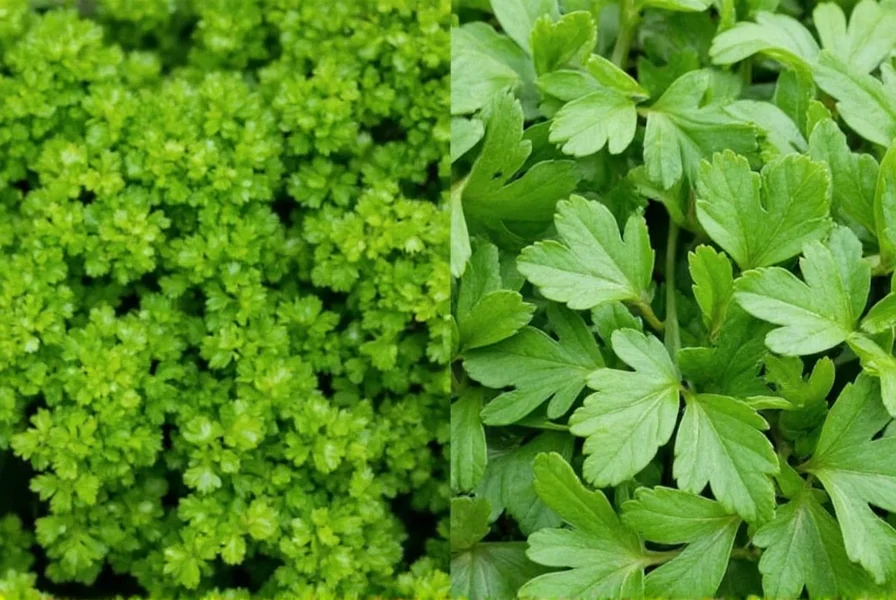Parsley has journeyed from ancient medicinal herb to modern kitchen staple. Originally cultivated in the Mediterranean region, this versatile herb now graces gardens and menus worldwide. Understanding the distinct characteristics between flat leaf parsley vs curly parsley helps home cooks select the right variety for specific culinary applications. While both types share similar nutritional profiles, their flavor intensity and texture differ significantly.
Botanical Background and Historical Significance
Belonging to the same family as carrots and celery, parsley's scientific name Petroselinum crispum derives from Greek words meaning "rock celery." Ancient Greeks crowned victors with parsley and associated it with death, while Romans used it as a breath freshener and garnish. By the Middle Ages, parsley gained acceptance as a culinary herb across Europe, moving beyond its initial medicinal applications for treating digestive issues and kidney problems.
Comparing Parsley Varieties
| Variety | Flavor Profile | Culinary Best Uses | Growing Characteristics |
|---|---|---|---|
| Curly Leaf | Milder, grassier flavor | Garnishes, soups, stews | More cold-tolerant, slower to bolt |
| Flat-Leaf (Italian) | Bolder, more robust flavor | Sauces, salads, Mediterranean dishes | Faster growth, preferred by chefs |
| Japanese Parsley | Distinctive celery-like notes | Asian cuisine, stir-fries | Cold-hardy, grows well in shade |
When considering flat leaf parsley vs curly parsley for cooking, professional chefs typically prefer flat-leaf varieties for their stronger flavor and easier chopping. Curly parsley's ruffled leaves provide excellent texture for garnishing while holding dressings better in salads. For gardeners exploring how to grow parsley indoors, both varieties adapt well to container gardening with proper drainage and consistent moisture.

Nutritional Powerhouse
Parsley's impressive nutritional profile makes it far more than just a garnish. A single cup (60g) of fresh parsley delivers:
- Over 1,300% of the daily value for vitamin K
- Nearly 100% of vitamin C requirements
- Substantial vitamin A (as beta-carotene)
- Good amounts of folate, iron, and potassium
Research indicates parsley contains apigenin, a flavonoid with potential anti-inflammatory properties. The herb's high chlorophyll content contributes to its natural breath-freshening qualities. When evaluating parsley nutritional benefits, note that drying significantly reduces vitamin C content while preserving vitamin K levels.
Culinary Applications Beyond Garnish
Professional kitchens utilize the entire parsley plant, recognizing that culinary uses for parsley stems extend far beyond the leaves. The stems contain concentrated flavor and work exceptionally well in mirepoix, stocks, and sauces. To maximize flavor impact:
- Chop leaves finely for salad dressings and finishing dishes
- Use whole stems when making vegetable stocks
- Create persillade (chopped parsley and garlic) for finishing meats
- Make gremolata with lemon zest, garlic, and parsley for osso buco
For those seeking substitution options, cilantro provides similar texture but distinct flavor, while celery leaves offer comparable appearance with milder taste. The best way to store fresh parsley involves treating it like flowers—trim stems and place in water, covering loosely with a plastic bag in the refrigerator.

Growing and Preservation Techniques
Successful cultivation starts with understanding how to grow parsley from seed, which has notoriously slow germination (2-5 weeks). Soaking seeds overnight improves sprouting rates. Plant in well-draining soil with partial sun exposure, keeping soil consistently moist. For indoor growing, select a south-facing window or use grow lights for 6-8 hours daily.
Preserving parsley for winter requires proper technique to maintain flavor. Freezing works better than drying for retaining nutritional value. Try these methods:
- Chop and freeze in ice cube trays with olive oil
- Create parsley pesto and freeze in portions
- Store whole sprigs in water in the refrigerator (change water every 2 days)
- Dehydrate leaves at low temperature (95°F/35°C) for long-term storage
Troubleshooting Common Parsley Issues
Yellowing leaves typically indicate overwatering or poor drainage. Parsley naturally yellows in its second year as it prepares to flower. To extend harvest, pinch off flower stalks promptly. Aphids and spider mites occasionally trouble plants—treat with insecticidal soap or strong water spray. When reviving wilted parsley, submerge in ice water for 15-20 minutes to restore crispness.
Frequently Asked Questions
What's the difference between flat leaf and curly parsley?
Flat-leaf (Italian) parsley has stronger flavor and is preferred for cooking, while curly parsley has milder taste and is often used for garnishing. Flat-leaf varieties are easier to chop and integrate into dishes, while curly parsley holds dressings better in salads.
How can I keep parsley fresh longer?
The best way to store fresh parsley is to trim the stems, place in a glass with 1-2 inches of water, and cover loosely with a plastic bag. Store in the refrigerator and change water every 2-3 days. This method typically keeps parsley fresh for 1-2 weeks.
Can I grow parsley indoors year-round?
Yes, you can grow parsley indoors with proper conditions. Use a container with drainage holes, well-draining potting mix, and provide 6-8 hours of direct sunlight or equivalent grow light exposure. Keep soil consistently moist but not waterlogged, and maintain temperatures between 60-75°F (15-24°C).
Are parsley stems edible and useful?
Yes, parsley stems are completely edible and contain concentrated flavor. Culinary uses for parsley stems include adding to stocks, chopping finely for sauces, or processing into pesto. The stems work particularly well in dishes requiring longer cooking times where their stronger flavor can mellow and infuse the dish.
Does cooking parsley reduce its nutritional value?
Cooking affects different nutrients variably. Vitamin C decreases with heat exposure, while vitamin K and certain antioxidants remain stable or become more bioavailable. To maximize nutritional benefits, add fresh parsley toward the end of cooking or use raw in finishing dishes and salads.











 浙公网安备
33010002000092号
浙公网安备
33010002000092号 浙B2-20120091-4
浙B2-20120091-4